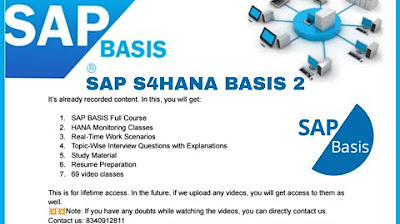SAP S/4HANA 2021 - Order-to-Cash
Summary
TLDRIn this S/4HANA 2021 session, Robin Bau highlights advancements in the order-to-cash process, focusing on open item clearing. The updated solution integrates applications for receivables management, credit control, and cash application. Key enhancements include support for various file types, new posting rules for user-friendly automation, and intelligent matching powered by machine learning. The payment advice process is revamped with lockbox integration and an API for data input. A new user interface simplifies payment advice annotation, streamlining the AR accountant's workflow.
Takeaways
- 🔍 The session focuses on the latest innovations in S/4HANA 2021, specifically in the Order-to-Cash process.
- 📊 One of the key highlights is the focus on open item clearing, a labor-intensive area within the process.
- 🔗 The Order-to-Cash portfolio combines applications like receivables management, credit management, and treasury integration.
- 💡 New innovations include supporting all relevant file types like bank statements, payment advice documents, and lockbox files.
- ⚙️ Posting rules can now be configured by end users directly, allowing easier automation without IT involvement.
- 🤖 Machine learning enhances intelligent matching for complex cases, significantly increasing automation rates.
- 📈 The new payment advice engine and lockbox functionalities further streamline and automate reconciliation processes.
- 🔧 A new API allows logbox files to be imported from any location, improving flexibility and data integration.
- 💼 The demo showcases how the Fiori application simplifies the payment advice processing and manual adjustments.
- ✅ Overall, the updates increase efficiency and simplify the life of AR accountants by enhancing automation and accuracy in item clearing.
Q & A
What is the main focus of this session on S/4HANA 2021 Order to Cash?
-The main focus of the session is on the open item clearing process, which is considered one of the most labor-intensive activities in Order to Cash. The session highlights recent innovations in automation for this process.
What does the Order to Cash solution portfolio consist of?
-The Order to Cash solution portfolio consists of various applications, including receivables management, collections, dispute and credit management, and BTP applications. These are all integrated into treasury and cash management processes.
What are some of the key improvements in the reconciliation process?
-Key improvements in the reconciliation process include support for a wide range of file types, such as payment advice documents and lockbox files, and the introduction of new posting rules and intelligent matching using machine learning.
What is the significance of the new posting rules in S/4HANA?
-The new posting rules in S/4HANA allow end users, particularly AR accountants, to configure rules directly from the user interface without IT involvement, making the clearing process more automated and user-friendly.
How does machine learning contribute to the reconciliation process?
-Machine learning is used for intelligent matching in complex cases, improving automation rates and helping to achieve faster and more accurate reconciliation of open items.
What improvements have been made to the payment advice process?
-The payment advice process has been renewed with the ability to feed in additional data, increasing automation. Lockbox information is now considered in the reconciliation process, and new functionalities have been added for easier handling of lockbox files.
How does the new lockbox application improve the reconciliation process?
-The new lockbox application streamlines the reconciliation process by allowing easy monitoring of progress and handling of exceptions. It also enables data to be fed into the system via an API, improving flexibility in data processing.
What are the capabilities of the new Payment Advice Annotation user interface?
-The new Payment Advice Annotation user interface allows users to view extracted payment advice information alongside the original document. Users can easily correct or adjust data directly in the interface, improving efficiency in the clearing process.
How does the system handle unstructured payment advice documents?
-The system uses machine learning to process unstructured payment advice documents, extracting key information such as invoice amounts and customer data, and converting it into a structured format for further processing and clearing.
What are the benefits of these innovations for AR accountants?
-These innovations simplify the life of AR accountants by automating many manual tasks, allowing for easy rule configuration, and improving the accuracy and efficiency of the open item clearing process.
Outlines

此内容仅限付费用户访问。 请升级后访问。
立即升级Mindmap

此内容仅限付费用户访问。 请升级后访问。
立即升级Keywords

此内容仅限付费用户访问。 请升级后访问。
立即升级Highlights

此内容仅限付费用户访问。 请升级后访问。
立即升级Transcripts

此内容仅限付费用户访问。 请升级后访问。
立即升级浏览更多相关视频

Order to Cash (O2C) Overview: SAP S4HANA Full Demo (GUI / FIORI)

How to Create a Purchase Order in SAP S/4HANA

SAP S4HANA BASIS 2

How to make Purchase order in Tally Prime | Tally me purchase order kaise banaye | #purchaseorder

BANK SENTRAL SISTEM PEMBAYARAN | KELAS X SEMESTER 2 | GRATIS PPT

[로드나인] 반드시 챙겨야할 컬렉션 우선순위 + 3배 싸게 맞추는 꿀팁
5.0 / 5 (0 votes)
